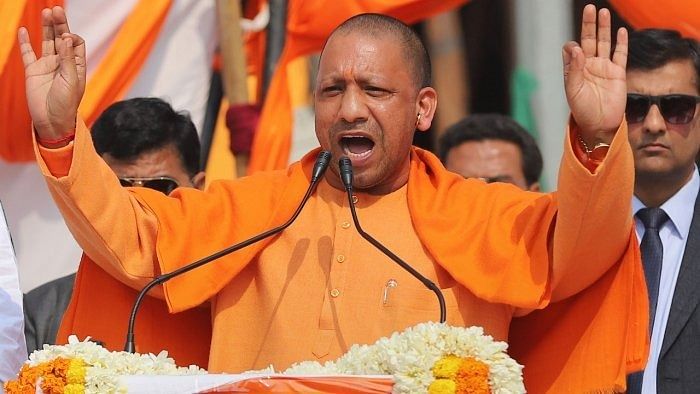
With the BJP going all out to polarise voters along communal lines ahead of the Uttar Pradesh Assembly elections six months from now, and its rivals making every effort to counter the same with ‘soft Hindutva’, the state is headed for a fierce, no-holds-barred, multi-cornered electoral battle.
For UP Chief Minister Yogi Adityanath, the “hardcore Hindutva poster boy”, the coming election is a “question of political survival”, and he has made it clear that his weapon to win it is communal polarisation.
The BJP leaders have been working on a two-pronged electoral strategy. While on the one hand, they have been showcasing the ‘developmental’ works undertaken to renovate important Hindu religious sites in Chitrakoot, Varanasi, Prayagraj, Mathura as well as the building of the Ram temple in Ayodhya to keep their core vote bank in good humour, they have also been trying to send the message that their rivals had indulged in the politics of minority appeasement and that Muslims were given preferential treatment during previous regimes.
Prime minister Narendra Modi’s reference, at a rally in Aligarh, to the migration of several Hindu families from Kairana in Shamli district, allegedly following threats by Muslims, and Adityanath’s ‘Abba Jaan (father, in Urdu) remark to claim that Muslims got preference over Hindus in the distribution of rations, are only pointers to the kind of election campaign the state is set to witness.
The BJP government in the state has also embarked on a name-changing spree in the hope of gaining electoral mileage, and it is expected that the names of around half a dozen districts will be changed, following demands by Hindutva outfits. So, Sultanpur may change to Kush Bhavanpur, Aligarh to Harigarh, Mainpuri to Mayanagar, Firozabad to Chandranagar, Mirzapur to Vindhya Dham, Agra to Agravan, and Muzaffarnagar to Laxminagar in the run-up to the polls.
The BJP is also trying to set its caste equations right before the polls by aligning with Apna Dal (AD), an outfit of the Kurmi community, which is a deciding factor in about 50 Assembly constituencies, especially in the eastern UP region. It is also trying desperately to hold on to Brahmin voters, who showed signs of resentment following allegations of persecution of the community under the Adityanath regime.
The ongoing farmers’ agitation is a concern for the BJP, which had swept the ‘Jat land’ in the western UP region in the 2017 Assembly polls as well as in the 2014 and 2019 Lok Sabha elections. “Jats are angry with the BJP, though the latter is trying to persuade them not to desert the party... It will be interesting to see if the party manages to hold on to them,” Gurubachan Singh, a Baghpat-based scribe, said.
The mismanagement of the second wave of Covid-19 is another headache for the BJP.
The Samajwadi Party (SP), which is the main opposition party in the state, has been trying to bring to its fold a section of the non-Yadav OBC voters in the hope that, coupled with the support of its core vote bank comprising Yadavs and Muslims, it will ensure a comfortable win for the party.
The SP has also entered into an electoral alliance with the Rashtriya Lok Dal (RLD), which got a new lease of life from the ongoing farmers’ agitation against the new farm laws as the Jats, who are at the forefront of the agitation, have signalled that they may return to its fold to defeat the BJP. The BSP supremo Mayawati, whose party was rocked by desertions and expulsions, too is nurturing dreams of winning a large number of seats by once again weaving her social engineering formula -- bringing together Dalits and Brahmins.
The BSP, which had a committed support base of around 10% Dalits, organised a series of ‘Prabuddh Sammelans’ for Brahmins, with the intention of bringing the community back into the BSP fold as it had done once.
Mayawati has also declared that she would focus on the development of the state instead of building memorials, parks and statues of herself and Dalit icons, as she had done in the past if her party is voted to power this time.
Struggling to remain politically relevant in the state, the Congress, under the leadership of party general secretary and state in-charge Priyanka Gandhi Vadra, has also been trying to strengthen its organisation and take up issues concerning the common people.
The Congress is going all out to make the forthcoming Assembly polls a four-cornered contest. It has also hinted that it may project a Brahmin face for the post of the chief minister, in an apparent bid to cash in on the perceived anger against the BJP in the community.
A few Congress leaders want Priyanka to be declared as the face of the party in the next polls. It is doubtful, however, that Priyanka will agree.
Political analysts also say that the election will be a three-cornered contest between the BJP, SP and BSP, though Congress may make it a four-cornered one in certain pockets.
“The contest will be mainly between BJP and SP. The BSP may be better placed on seats with a sizeable Dalit population. Congress will also be in the fray in some pockets,” according to political analyst J P Shukla.
AIMIM leader Asaduddin Owaisi might queer the pitch for the opposition parties in Uttar Pradesh by causing a division of Muslim votes, which will only help the BJP.